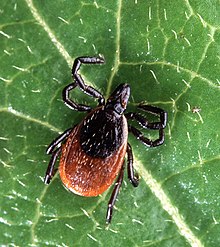| Ixodes scapularis | |
|---|---|

| |
| Adult female deer tick | |
| Scientific classification | |
| Domain: | Eukaryota |
| Kingdom: | Animalia |
| Phylum: | Arthropoda |
| Subphylum: | Chelicerata |
| Class: | Arachnida |
| Order: | Ixodida |
| Family: | Ixodidae |
| Genus: | Ixodes |
| Species: | I. scapularis
|
| Binomial name | |
| Ixodes scapularis Say, 1821
| |

| |
| Synonyms[1] | |
| |
Ixodes scapularis is commonly known as the deer tick or black-legged tick (although some people reserve the latter term for Ixodes pacificus, which is found on the west coast of the US), and in some parts of the US as the bear tick.[2] It was also named Ixodes dammini until it was shown to be the same species in 1993.[3] It is a hard-bodied tick found in the eastern and northern Midwest of the United States as well as in southeastern Canada. It is a vector for several diseases of animals, including humans (Lyme disease, babesiosis, anaplasmosis, Powassan virus disease, etc.) and is known as the deer tick owing to its habit of parasitizing the white-tailed deer. It is also known to parasitize mice,[4] lizards,[5] migratory birds,[6] etc. especially while the tick is in the larval or nymphal stage.

- ^ "Ixodes scapularis Say, 1821". Global Biodiversity Information Facility. Retrieved 11 April 2024.
- ^ Drummond, Roger (2004). Ticks and What You Can Do about Them (3rd ed.). Berkeley, California: Wilderness Press. p. 23. ISBN 978-0-89997-353-1.
- ^ Patnaude, Michael R.; Mather, Thomas N. (December 2014) [Originally published July 2000]. Rhodes, Elena (ed.). "Deer tick, Ixodes scapularis Say". Featured Creatures. Photographs by Michael R. Patnaude, web design by Kay Weigel. University of Florida Entomology & Nematology, Institute of Food and Agricultural Sciences. Retrieved 11 April 2024.
- ^ Mannelli, A; Kitron, U; Jones, C. J.; Slajchert, T. L. (1994). "Influence of season and habitat on Ixodes scapularis infestation on white-footed mice in northwestern Illinois". The Journal of Parasitology. 80 (6): 1038–42. doi:10.2307/3283457. JSTOR 3283457. PMID 7799148.
- ^ Levine, J. F.; Apperson, C. S.; Howard, P; Washburn, M; Braswell, A. L. (1997). "Lizards as hosts for immature Ixodes scapularis (Acari: Ixodidae) in North Carolina". Journal of Medical Entomology. 34 (6): 594–8. doi:10.1093/jmedent/34.6.594. PMID 9439111.
- ^ Ogden NH, Lindsay LR, Hanincová K, Barker IK, Bigras-Poulin M, Charron DF, Heagy A, Francis CM, O'Callaghan CJ, Schwartz I, Thompson RA (2008). "Role of migratory birds in introduction and range expansion of Ixodes scapularis ticks and of Borrelia burgdorferi and Anaplasma phagocytophilum in Canada". Applied and Environmental Microbiology. 74 (6): 1780–90. Bibcode:2008ApEnM..74.1780O. doi:10.1128/AEM.01982-07. PMC 2268299. PMID 18245258.